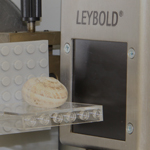High-resolution reconstruction of a frog
The video shows the reconstruction of a frog (approx. 2.5 cm long), recorded with the X-ray image sensor.
Stereoscopic view of a snail shell
The video below shows the beauty of a snail shell, recorded with the X-ray image sensor.
Stereoscopic view of a bug
The video shows the tomogram of a bug (approx. 2 cm long) in stereoscopic view, recorded with the X-ray image sensor.
Stereoscopic view of two Lego figures
The video below shows two Lego figures, recorded with the computed tomography module.
In 1963 and 1964 Allan Cormack published the theoretical foundations of computer tomography in the Journal of Applied Physics. In 1972 the first computed tomographic scanner was built by Godfrey Hounsfield who, together with Allan Cormack, was awarded the Nobel Prize in Physiology or Medicine in 1979. The basic idea of computerised tomography is the illumination of an object by X-rays from numerous different angles.
Our educational X-ray apparatus (preferred with W tube or Au tube) allows the illumination of objects by X-rays. The resulting 2D-projections are visualised at the fluorescence screen. These projections have a relatively low intensity. Therefore a camera of high sensitivity has to be used to record the various projections. Such a camera is implemented in the computed tomography module.
The new X-ray image sensor provides significantly better resolution tomograms. It captures the image inside the experimental chamber and can be used instead of computed tomography module.
By turning an object using the built-in goniometer of the X-ray apparatus, and recording the 2D-projections from each angular step, the computer can reconstruct the object illuminated by X-rays. Our e-learning software visualises the back projection (necessary for reconstructing the computed tomogram) concurrently with the scanning process. The 3D-model is then displayed on the PC screen.
Download Software Computed Tomography (Version 2.10)
| Language | Software (32+64 bits, MSI) | Manual (PDF) |
|---|---|---|
| GER | Computertomografie | Handbuch |
| ENG | Computed Tomography | Manual |
| FRA | Tomodensitométrie | Manuel utilisateur |
License
You can view and examine the examples in 2D, 3D and in stereoscopic view with a suitably powerful computer. However the examples contain only the first 10 projections. Therefore you can not completely recalculate the tomograms.
If you want to create own CT scans, you need a license of the software that is included in the computed tomography module or can be purchased as the software Computed tomography Pro.
Example tomograms in different resolutions
| Resolution | Download (ZIP) | Download (ZIP) | Download (ZIP) |
|---|---|---|---|
| CT module (300 µm) | Frog (16 MB) | Surprise Egg (12 MB) | Indians (50 MB) |
| X-ray image sensor (96 µm) | Frog (52 MB) | Bug (60 MB) | Snail shell (62 MB) |
| X-ray image sensor (48 µm) | Frog (450 MB) | Bug (450 MB) | Snail shell (470 MB) |
System requirements
Recommended system requirements using the computed tomography module:
- Windows 7/8/10/11 (32 bits or 64 bits) with .NET Framework 4
- Dual-core processor 2.4 GHz
- 3 GB RAM
- 3D graphics card with 1 GB RAM (middle-sized class)
Recommended system requirements using the X-ray image sensor:
- Windows 10/11 (64 bits)
- Quad-core processor 3 GHz
- 8 GB RAM
- 3D graphics card with 3 GB RAM (performance class)





